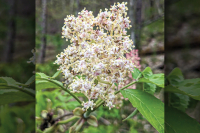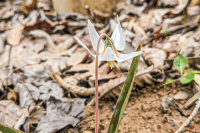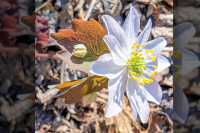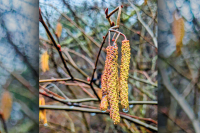Word from the Smokies: Discover Life in America presents conservation author on Earth Day
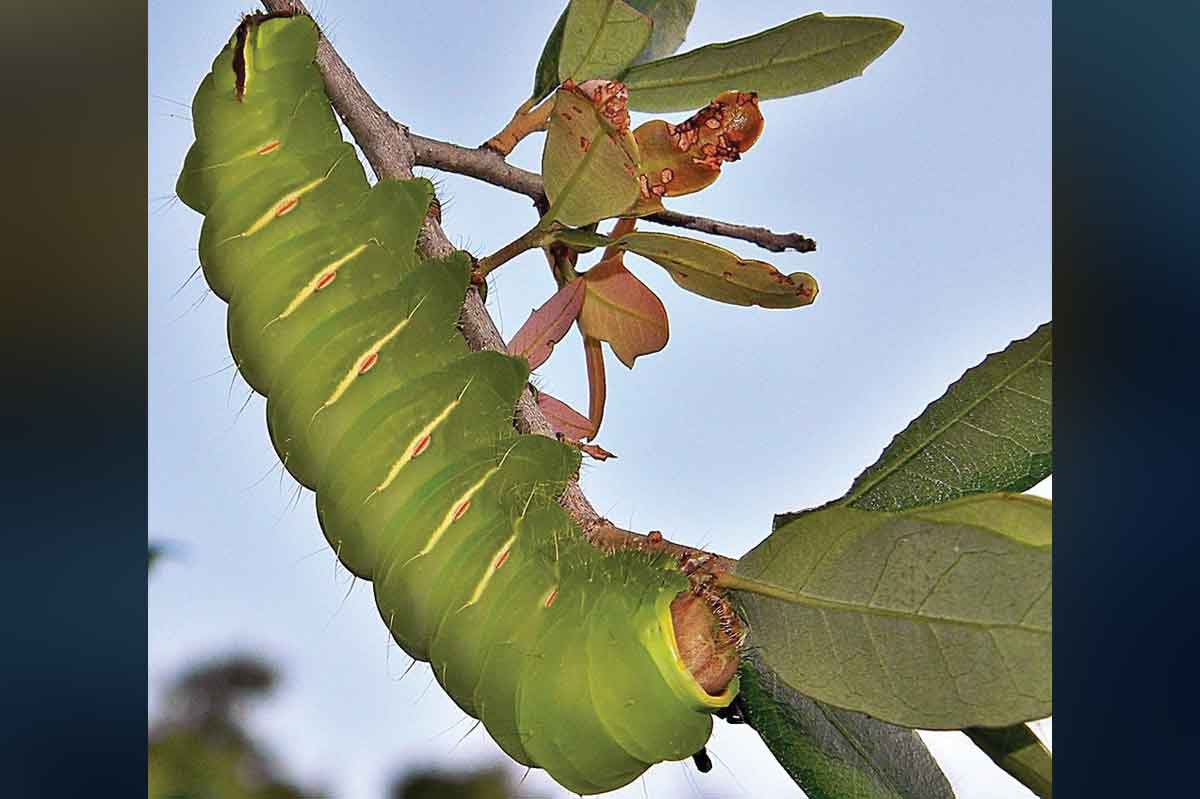 The polyphemus moth caterpillar is one of more than 1,000 species of caterpillar supported by oak trees, a keystone tree species. There is no other plant genus that comes close to that number; tulip trees, by comparison, support only 21 species of caterpillar. So, it’s important to choose keystone species to plant on your property in order to positively affect the biodiversity crisis. Bob Peterson photo
The polyphemus moth caterpillar is one of more than 1,000 species of caterpillar supported by oak trees, a keystone tree species. There is no other plant genus that comes close to that number; tulip trees, by comparison, support only 21 species of caterpillar. So, it’s important to choose keystone species to plant on your property in order to positively affect the biodiversity crisis. Bob Peterson photo
Doug Tallamy had been teaching at the University of Delaware for a quarter of a century when he had an epiphany: People who want to do something good for the planet have the ability to effect change immediately by choosing plants that share their energy with other beings, as opposed to those that don’t. And they get to see positive results in real time in their own yards.
“The public loves that,” he says, “and I love that.”
A professor in UD’s Department of Entomology and Wildlife Ecology, Tallamy has written several books about how simple stewardship at home can have a positive effect on the biodiversity crisis and make a big difference for overall ecosystem health. These include “Bringing Nature Home: How You Can Sustain Wildlife with Native Plants” and the New York Times bestseller “Nature’s Best Hope: A New Approach to Conservation That Starts in Your Yard.”
He will be the keynote speaker this year on Earth Day, April 22, as park partner Discover Life in America celebrates its 25th anniversary in Great Smoky Mountains National Park. One of the things he’ll be talking about is his Homegrown National Parks initiative to promote and record successful conservation on private property.
“When I was in graduate school in the 70s, we learned about host-plant specialization and co-evolution, the idea that if you take milkweed away, the monarch is not going to eat something else — and that’s true for 90 percent of the insects,” Tallamy says. “What we didn’t know, or I wasn’t following, was the degree to which non-native plants that don’t have these interactions have replaced native plants all over the place.”
This truth became real for Tallamy when he and his wife moved onto 10 acres in Oxford, Pennsylvania, in 2000. The land was impenetrable, thick with bittersweet, Japanese honeysuckle and bush honeysuckle. Clearing and restoring the land with native plants, Tallamy grasped the extent to which non-life-sustaining species are now pervading landscapes everywhere.
Related Items
“Even if we’re not using invasive plants, they are still non-native, and they are still not supporting anything,” he figured. This led to more investigation into how humans tend to landscape with ornamental species that don’t support other life. “When I looked into the literature, I found a big, long list of reasons why non-native plants are not great, but wrecking the food web wasn’t on that list.”
Then, sitting in his kitchen on a Sunday morning in 2007, he came across the statistic that we in the US have 40 million acres of lawn. He thought: What if we cut that area in half and put it towards conservation? If you add up the acreage in national parks, how long would it take to reach 20 million acres? He started adding up some of the big ones — Denali, Katmai, Death Valley, Yellowstone, the Everglades, Grand Canyon, Glacier, Big Bend, Joshua Tree, the Smokies — and it still didn’t come near to 20 million acres. If we preserved private lands, Tallamy thought, we could create the biggest national park in the country — at home.
So Tallamy developed the Homegrown National Park initiative to create viable habitats outside of parks, forming connectivity between preserved lands so that the conservation activities inside of the parks can become more meaningful.
“More than 78% of the U.S. is privately owned, and 85% east of the Mississippi is privately owned,” he says. “To succeed we must do conservation on that private property. We’ll be able to sustain these species a whole lot longer if we extend our conservation reach beyond parks and preserves and create viable habitat outside the protected land.”
Examples of how to do this can be found in the most recent of Tallamy’s titles, “The Nature of Oaks: The Rich Ecology of Our Most Essential Native Trees,” which won the American Horticultural Society’s 2022 Book Award and earned Tallamy the Asheville EcoForesters 2022 Root Cause Award for his commitment to natural communities and the benefits they provide.
As he explains in the book, healthy oak trees support hundreds of species, play a vital role in maintaining insect populations and go a long way toward sustaining wildlife.
“Caterpillars are the bread and butter of terrestrial food webs,” Tallamy says. “So, they are transferring more energy from plants to other animals than any other type of plant eater. In short, if you don’t have a landscape that supports a lot of caterpillars, you are going to have a failed food web.”

- Doug Tallamy (above) is a professor in the Department of Entomology and Wildlife Ecology at the University of Delaware. His books include “Bringing Nature Home: How You Can Sustain Wildlife with Native Plants” and the New York Times bestseller “Nature’s Best Hope: A New Approach to Conservation That Starts in Your Yard.” He will speak in Great Smoky Mountains National Park on Earth Day. Rob Cardillo photo
Tallamy and his lab ranked the plant genera throughout the country in terms of their ability to support caterpillars, discovering that 14% of our native plants are supporting 90% of the caterpillars. Oaks support over 1,000 species of caterpillar, and no other plant genus comes close. (The tulip tree supports only 21.) Without one or more keystone species, the bulk of the caterpillars are lost from the landscape. Then the chickadees can’t breed, red foxes lose 25% of their diets, black bears cannot get enough natural food to get through the winter, and the list of catastrophic effects goes on and on.
Back on their 10-acre property, Tallamy and his wife have been counting the species now thriving there, and in 23 years, 1,199 have come back.
“That’s 44% of all the species found in the entire state of Pennsylvania, and it’s because we put the plants back,” he says. “What would happen if everybody put the plants back? We really could turn these terrible statistics around, and that’s a motivating force that has changed the direction of my research.”
Tallamy says humans are so detached from nature that we think a few conservation biologists and ecologists do conservation and we’re not part of it — which for some translates into a green light to destroy the ecosystem.
“Because of this private property connection and because everybody on the planet requires healthy ecosystems, it’s our responsibility, everybody’s,” he says. “If it helps to empower you, don’t think about the entire planet and its problems, just worry about your one little piece of the planet. We can even be selfish about this and do it because our lives depend on it!”
On Saturday, April 22, the public is welcome to join a free, family-friendly open house at Twin Creeks Pavilion in the Smokies from 10 a.m. to 2 p.m. There will be live music, lunch, tours of the natural history collections, nature programs and opportunities to meet and talk with scientists and park biologists. Then, starting at 6 p.m., there is a reception followed by Tallamy’s talk and book signing at 7 p.m. at Gatlinburg’s Park Vista hotel, 705 Cherokee Orchard Road. Tickets are $10. Learn more and register at dlia.org.
DLiA’s mission is to discover, understand and conserve biological diversity. Its flagship project, the All Taxa Biodiversity Inventory, is a joint effort with the National Park Service to identify and understand every species within Great Smoky Mountains National Park. To date, DLiA has helped add nearly 12,000 species to the inventory of life in the park, including 1,063 that are new to science.
Frances Figart (rhymes with Tiger) is the editor of Smokies Life and the Creative Services Director for the 29,000-member Great Smoky Mountains Association, an educational nonprofit partner of Great Smoky Mountains National Park. Reach her at frances@gsmassoc.org.





